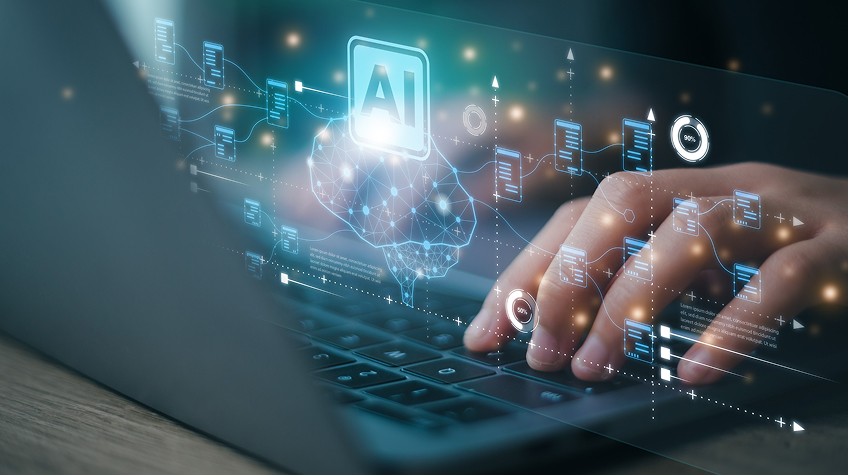
AI in eLearning is transforming the way businesses train, develop and compete. It saves time, reduces costs and assists employees to learn smarter. AI-based tools are now being employed by companies to not only train teams, but also influence how they think, behave and perform in the real world. Let’s understand why and how businesses are changing by integrating AI in e-learning.
Businesses have changed how they train their people, and AI is leading that change. Enterprises are not only training skills nowadays. They are creating learning systems that think, adapt and become better every day. The old-fashioned training techniques are no longer relevant in this digital and fast-paced world. AI-driven e-Learning is assisting companies to remain on their feet and expand quickly.
In the past, learning at work was associated with manuals, classrooms, and long videos. Now, it has become personal, fast and data-driven. AI knows who you are, how you study and what you should get next. It is not replacing the human teaching; it is just making it smarter.
Businesses that apply AI to eLearning achieve desired outcomes, improved employee performance, shorter training cycles, and higher productivity. Here’s how it impacts business growth
Table of Contents
- The New Era of Learning: Personalised and Predictive
- Data That Drives Decisions
- Smarter Onboarding That Scales Effortlessly
- Continuous Learning Becomes the New Normal
- Engaging Learning Experiences That Actually Stick
- AI and the ROI of Learning
- Breaking Language and Cultural Barriers
- The Rise of AI Tutors and Virtual Mentors
- Building a Future-Ready Workforce
➢ AI in eLearning for Business Growth
1. The New Era of Learning: Personalised and Predictive
Old-fashioned eLearning was like reading a textbook – same lessons, same speed, same outcomes. AI changes that. Learning with AI becomes dynamic. It examines the way employees respond to the content, such as the amount of time they spend on lessons, areas of difficulty, and what they do not cover, and modifies the course based on this information.
Consider two employees undertaking the same module. One of them goes through the fundamentals; the other one requires time. AI is aware of this and automates each course. This results in each and every person learning effectively, at their own pace, without being left behind or bored.
Such a high level of personalisation increases retention and engagement. Employees feel seen. The learning feels relevant. And when learning is personalised, performance gets better.
2. Data That Drives Decisions

Businesses run on data, and AI in eLearning provides a treasure. Each click, quiz, and completion narrates a story. The information can be gathered and analysed by AI tools, and provide leaders with profound insights into the learning and performance of teams.
On the one hand, managers can immediately notice which courses are most successful or which departments lag. They do not guess where the gaps lie; they know, and they can do something about it. This culture of data-based learning makes certain that the training process is not only taking place but also functioning.
Based on the performance pattern, enterprises are able to refine programs, improve content as well and predict which skills are required next. In simple terms, AI will make the business’s power more effective.
3. Smarter Onboarding That Scales Effortlessly
The onboarding of new employees can be hectic and costly. However, AI-based eLearning transforms the game. AI systems are used to develop individualised orientation paths as opposed to generic orientation videos. They evaluate the background, job and level of skills of every new employee, and provide them with training content that fits their needs.
It doesn’t stop there. New employees can have access to AI chatbots 24/7 to respond to questions, give advice, and recommend further actions, as well as help new employees adapt sooner. This scalability is invaluable to large businesses recruiting in multiple locations and time zones. It guarantees regular quality and experience to all the new team members, without straining the HR departments.
By making the onboarding smart and easy, new employees get to work fast, and that contributes to more business being generated rapidly.
4. Continuous Learning Becomes the New Normal
Skills in the modern world become obsolete faster than ever. What is relevant today may not be relevant next year. This is why businesses cannot afford training once in a lifetime anymore; they have to learn constantly. AI makes that possible. It keeps track of employee advancement and suggests new courses or modules automatically, depending on the changes in roles or performance trends.
For example, in case a marketing expert is interested in data analytics, the AI can propose higher-level lessons in analytics to develop this ability further. This proactive learning makes the employees future-savvy and ensures that the business will always have the talent to remain ahead of the pack.
5. Engaging Learning Experiences That Actually Stick
The reality is, most corporate training is boring. Slides, PDFs, and lengthy videos; it is no wonder that employees switch off. AI changes that experience. It drives interactive learning through chatbots, gamification, simulations, and virtual mentors, resulting in an engaging and even entertaining process.
Imagine Netflix suggesting learning courses, but for learning. The AI analyses behaviour and presents appropriate and interesting lessons that match the objectives of the learner. Gamified modules and simulators encourage progress and give an opportunity to use knowledge in practice, and virtual assistants provide immediate feedback.
This maintains motivation and high learning outcomes in learners. With learning being made engaging, it is not a burden anymore, but a competitive edge.
6. AI and the ROI of Learning
Any dollar invested in training must lead towards growth, and AI can help demonstrate that. Businesses can monitor the immediate effect of training on performance indicators such as sales, productivity, and retention through analytics dashboards.
Suppose your sales team had attended an AI-based product training course. After training, AI tools will be able to determine whether their conversion rates increased or customer interaction became more efficient. This connection between learning and outcomes makes L&D teams more responsible, and is why executives are more willing to invest more in training.
7. Breaking Language and Cultural Barriers
Businesses are now international. Teams are cross-global, cross-cultural, and cross-linguistic – and training must also follow suit. Localisation becomes easy with AI. It is able to convert content in real-time, localise tone and examples, and even make visuals culturally sensitive.
This inclusivity would mean that everybody, no matter the location of work, receives equal access to high-quality learning experiences. In international companies, it is not only advantageous but is necessary for well-being, cooperation, and consistency.
8. The Rise of AI Tutors and Virtual Mentors
Human trainers are not everywhere, but AI can be. AI-based virtual mentors can respond to employee inquiries in real-time, offer feedback, and offer advice 24/7. These digital assistants make the process of learning more approachable and less threatening.
Employees do not need to wait until the next workshop or feel embarrassed by asking simple questions; they can simply chat with their AI mentor any time. This support motivates a culture of curiosity, where employees are encouraged to learn every time they need to do so. In the long run, such curiosity is the source of innovation.
9. Building a Future-Ready Workforce
AI is not only enhancing existing learning, but it is also getting a business ready for the future. AI assists businesses with planning in the future by identifying the gaps in skills as well as anticipating future demands. It will be able to recognise the roles that can be automated, the skills that will become more in demand, and how to reskill employees as effectively as possible.
This vision makes training a development plan. Enterprises can be ahead of change rather than responding to it. In an environment where the digital transformation is rapid, the ultimate advantage is to have a workforce that is always prepared.
➢ Why AI Is Becoming the Heart of Modern eLearning?
The fact is, businesses no longer have much of an option. Learning through AI is more efficient, smarter, and quicker than conventional methods. It is time-saving, cost-cutting, and the results are measurable and visible.
However, beyond this, it meets the expectations of modern employees perfectly, which includes personalisation, flexibility, and growth.
With the increasing level of competition and the pace of innovation, companies that adopt AI in eLearning are not only enhancing training, but they are also creating a culture of learning that will lead to sustainable business success in the long run.
Conclusion
AI in eLearning is not just a technology trend; it is the next stage of business development. It changes the way companies train, assess and empower their teams. It makes learning more performance-focused and growth continuous, measurable and sustainable.
It is simple: the faster the employees learn, the faster the businesses develop. And as AI takes the lead, the future of enterprise learning becomes smarter, more human, and more influential than ever






